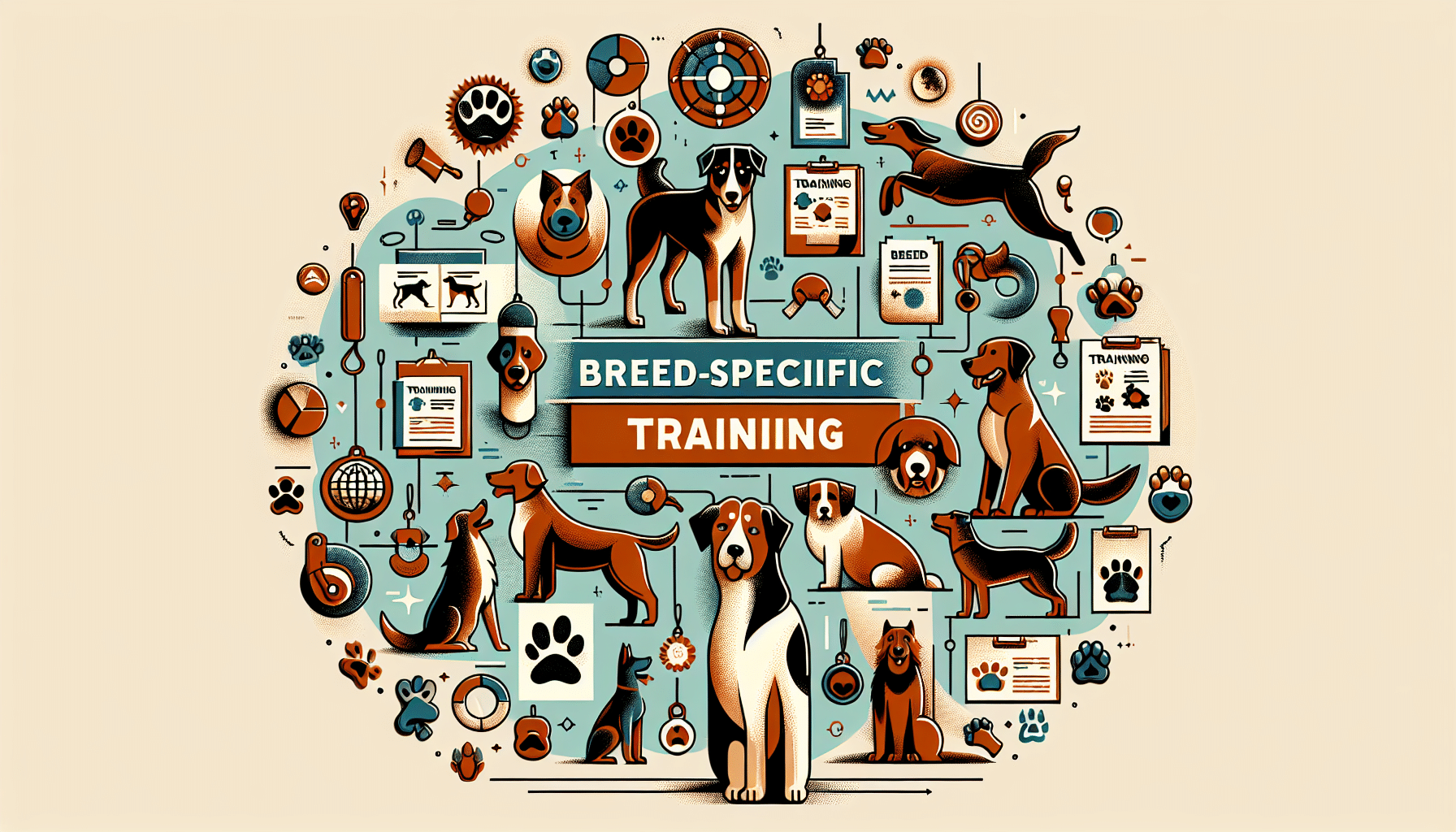Are you struggling with training your dog? It can be challenging, especially when every breed has its own unique set of behaviors and characteristics. But fret not, because we are here to help! In this article, we will explore the world of breed-specific behavior training guides and how they can assist you in effectively training your furry friend. Whether you have a high-energy Border Collie or a laid-back Bulldog, finding the perfect training guide tailored to your dog's breed can make all the difference in their behavior and obedience. So, let's dive in and discover the best breed-specific behavior training guide for your beloved canine companion!

This image is property of images.pexels.com.
Understanding Your Dog's Breed
Researching Your Dog's Breed Characteristics
Understanding your dog's breed characteristics is essential for effective training. Researching your dog's breed will give you insights into their natural instinctive behaviors, energy levels, and potential challenges. By understanding these breed-specific traits, you can tailor your training approach to better suit your dog's individual needs.
Considering the Breed's History and Purpose
Every dog breed was originally bred for a specific purpose. Some were bred for herding, while others were bred for hunting or guarding. Considering your dog's breed history and purpose can provide valuable context for their behavior. For example, herding breeds may have a strong instinct to chase and nip at moving objects, which can be important to keep in mind during training.
Identifying Unique Behavioral Traits
Each dog breed has its own unique behavioral traits. Some breeds are known to be highly intelligent and trainable, while others may be more independent or prone to certain behavior problems. Identifying these unique traits can help you better understand your dog's natural inclinations and adjust your training accordingly. For example, some breeds may have a tendency to dig or bark excessively, requiring specific training interventions.
The Importance of Breed-Specific Training
Addressing Breed-Specific Challenges
Breed-specific training is crucial for addressing the specific challenges and tendencies of your dog's breed. For example, brachycephalic breeds, such as Bulldogs, may require special attention to prevent overheating during exercise. By understanding these challenges, you can implement specific training techniques to overcome them and ensure the well-being of your furry companion.
Promoting Mental and Physical Stimulation
Different breeds have different exercise and mental stimulation needs. Some breeds require high levels of physical activity, while others may excel in mental tasks or puzzles. Breed-specific training can incorporate activities that cater to your dog's unique needs, providing them with the necessary mental and physical stimulation for a happy and content life.
Enhancing the Bond with Your Dog
Training your dog based on their breed not only helps address behavior issues and challenges but also strengthens the bond between you and your furry friend. When you understand and cater to your dog's breed-specific needs, you are more likely to have a successful and enjoyable training experience. This, in turn, deepens the connection and trust you share with your beloved pet.

This image is property of images.pexels.com.
Factors to Consider in Choosing a Training Guide
Training Goals and Objectives
Before choosing a training guide, it is important to determine your training goals and objectives. Are you looking to address specific behavior issues or simply want to teach basic obedience commands? By clarifying your training goals, you can choose a guide that aligns with your aspirations and helps you achieve the desired results.
Experience and Knowledge Level
Consider your own experience and knowledge level when selecting a training guide. Some guides may be more suitable for beginners, providing step-by-step instructions and explanations. Others may target more advanced trainers who are looking to tackle complex behavior problems. Choosing a guide that matches your skill level will ensure you can effectively implement the training techniques.
Training Methods and Techniques
Different training guides may utilize various methods and techniques. Some guides may focus on positive reinforcement, while others incorporate disciplinary measures. It is important to select a guide that aligns with your personal training philosophy and approach. Remember, training should always be based on trust, respect, and kindness towards your dog.
Availability of Resources and Support
Consider the availability of resources and support provided by the training guide. Are there video demonstrations or online communities where you can seek additional guidance? A guide that offers comprehensive resources and ongoing support can be invaluable in ensuring your training journey is smooth and successful.
Popular Breed-Specific Training Guides
Guide 1: Labrador Retriever Training Handbook
The Labrador Retriever Training Handbook is specifically tailored to meet the needs of Labrador Retrievers, a popular breed known for their intelligence and friendly nature. This guide focuses on obedience training, problem-solving, and behavior modification techniques suitable for Labradors of all ages.
Guide 2: German Shepherd Behavior Training Manual
German Shepherds are known for their loyalty and versatility. The German Shepherd Behavior Training Manual provides breed-specific guidance on leash training, protection training, and advanced obedience. This guide is ideal for German Shepherd owners who want to unlock their dog's full potential.
Guide 3: Golden Retrievers: From Puppies to well-behaved Companions
Golden Retrievers are beloved for their gentle nature and eagerness to please. This guide offers step-by-step instructions on basic commands, leash training, and specialized activities such as retriever training and therapy dog preparation. It is perfect for Golden Retriever owners looking to build a strong bond with their furry companions.
Guide 4: Bulldog Training 101
Bulldogs have their own unique needs and challenges, and the Bulldog Training 101 guide caters specifically to these lovable and sometimes stubborn companions. This guide provides strategies for addressing common Bulldog behavior issues, leash training, and promoting mental and physical exercise suitable for the breed.
Guide 5: Poodle Behavior Training Made Easy
Poodles are highly intelligent and require mental stimulation alongside their physical exercise. The Poodle Behavior Training Made Easy guide focuses on optimizing the intelligence and obedience of Poodles. It covers advanced commands, trick training, and activities specifically designed to challenge and engage the curious minds of Poodles.

This image is property of images.pexels.com.
Evaluating the Training Guides
Reviews and Testimonials
Before making a final decision, it is important to consider reviews and testimonials from other dog owners who have used the training guides. Look for feedback on the effectiveness of the techniques, the clarity of instructions, and the overall usefulness of the guide in addressing breed-specific training challenges.
Author's Expertise and Credentials
Review the expertise and credentials of the guide's author. A reputable author with experience in dog training or expertise in a specific breed will provide added confidence in the effectiveness and reliability of the training guide.
Content and Structure
Assess the content and structure of the training guide. Is it well-organized and easy to follow? Does it provide clear explanations and demonstrations? A well-structured guide will make it easier for you to understand and implement the training techniques effectively.
Specificity to the Breed
Consider whether the training guide is specific to your breed. While general training guides can be helpful, a breed-specific guide will address the unique challenges and needs of your dog's breed more comprehensively.
Ease of Understanding and Implementation
Choose a guide that is easy to understand and implement. Look for guides that use concise language, provide visual aids or demonstrations, and offer clear instructions. Training should be a rewarding and enjoyable experience for both you and your dog, so a guide that makes learning easy and fun is essential.
Availability and Additional Resources
Check if the training guide offers additional resources such as online videos, articles, or forums. These resources can be valuable for ongoing support and further understanding of the training techniques. Guides that provide extra resources ensure that you have access to continued learning and guidance throughout your training journey.
Customizing the Training Guide to Your Dog
Adapting Training Techniques to Fit Your Dog's Individuality
While breed-specific training guides offer valuable insights, it is essential to adapt the techniques to fit your dog's individual personality and temperament. Each dog is unique and may respond differently to various training methods. Pay attention to what motivates and engages your dog and adjust the training techniques accordingly for optimal results.
Tailoring the Training Program to Accommodate Your Dog's Age and Developmental Stage
Dogs go through different developmental stages, and their training needs may change as they age. A training guide that provides guidelines for different age groups will help you tailor the training program to suit your dog's specific stage of development. Puppies, adolescents, and adult dogs all have distinct training requirements that should be taken into consideration.
Modifying Strategies for Different Energy Levels
Energy levels vary among dog breeds. Some dogs are naturally high-energy while others are more laid-back. Adapting the training strategies to suit your dog's energy level is crucial for a successful training experience. High-energy breeds may require more physical exercise and mental stimulation, while low-energy breeds may benefit from shorter training sessions and creative playtime.
Incorporating Breed-Specific Mental and Physical Exercise
Breed-specific mental and physical exercises are vital for keeping your dog stimulated and happy. Consider incorporating activities that align with your dog's breed characteristics. For example, scent work for hound breeds, agility training for herding breeds, or puzzle toys for intelligent breeds. Customizing the training program to include these activities will enhance your dog's overall well-being and prevent behavioral issues caused by boredom.

Training Guide Supplements and Resources
Training Aids and Tools
Training aids and tools can complement your chosen training guide. Tools such as clickers, treats, and target sticks can assist in teaching and reinforcing desired behaviors. Consult your training guide to see if it recommends any specific tools and how to effectively use them.
Online Communities and Support Groups
Joining online communities and support groups can provide invaluable support and advice throughout your training journey. Connecting with fellow dog owners who have gone through similar experiences can offer insights, troubleshooting tips, and a sense of camaraderie. These communities can be found through social media platforms, forums, or dedicated training websites.
Professional Training Classes and Workshops
Professional training classes and workshops can be excellent supplements to your chosen training guide. In-person training sessions provide hands-on guidance from experienced trainers, allowing you to address specific concerns and receive personalized feedback. Look for classes or workshops that specialize in your dog's breed or the specific training areas you wish to focus on.
Consulting with Breed-Specific Trainers
If you encounter specific challenges or need expert advice, consider consulting with a breed-specific trainer. These trainers have expertise in working with particular breeds and can provide tailored guidance for your dog's unique needs. A breed-specific trainer can help you troubleshoot training issues, refine techniques, and maximize the effectiveness of your training efforts.
Implementing the Training Guide
Establishing a Consistent Routine and Environment
To ensure successful implementation of your chosen training guide, establish a consistent routine and environment for training sessions. Dogs thrive on consistency, so scheduling regular training sessions and using the same designated area for training will help them understand that it is time for focused learning.
Setting Clear Expectations and Boundaries
Setting clear expectations and boundaries is essential for effective training. Consistently communicate to your dog what behaviors are acceptable and what are not. Be firm but fair in enforcing these boundaries, and reward your dog for demonstrating the desired behaviors. Clear expectations provide structure and guidance for your dog, helping them understand what is expected of them.
Positive Reinforcement and Reward Systems
Positive reinforcement is a powerful tool in training your dog. Rewards, such as treats, praise, or playtime, can be used to reinforce desired behaviors. Incorporate a reward system into your training program, ensuring that your dog associates their good behavior with positive outcomes. This will motivate them to repeat those behaviors in the future.
Correcting and Redirecting Undesired Behaviors
Alongside positive reinforcement, it is important to address and redirect undesired behaviors. Rather than resorting to punishment, focus on redirecting your dog's attention and rewarding alternative behaviors. For example, if your dog jumps on guests, teach them to sit and reward them for staying calm. Consistency and patience are key when correcting and redirecting undesired behaviors.

Monitoring Progress and Adapting the Training Program
Assessing Behavioral Changes and Improvements
Regularly assess your dog's behavioral changes and improvements throughout the training process. Keep track of their progress in areas such as obedience, impulse control, or reaction towards specific triggers. Celebrate small victories and adjust the training program based on your dog's strengths and weaknesses.
Identifying Challenges and Making Adjustments
Challenges may arise during the training journey. Identify any areas where your dog may be struggling and make necessary adjustments to address those challenges. This may involve revisiting specific techniques, seeking additional resources, or consulting with professionals for guidance. Adapting the training program as needed will ensure continued progress and growth.
Seeking Professional Help if Needed
In some cases, seeking professional help may be necessary. If you are encountering persistent behavior problems or struggling to make progress with your training program, reach out to a qualified dog trainer or behaviorist. They can provide expert guidance, assess your dog's unique situation, and develop a tailored plan to address the specific challenges you are facing.
Long-Term Behavioral Maintenance
Continuing Training and Reinforcement
Training is an ongoing process, even after your dog has learned basic obedience commands or overcome initial behavior issues. Continually reinforcing learned behaviors through intermittent training sessions helps maintain your dog's skills and prevents regression. Regularly mix training exercises into your daily routine to keep your dog mentally engaged and responsive.
Regular Mental and Physical Exercise
Physical and mental exercise are crucial for your dog's overall well-being. Regular walks, play sessions, and engaging mental stimulation activities should be incorporated into their daily routine. These exercises not only help expel excess energy but also prevent boredom, which can lead to destructive or undesirable behaviors.
Providing a Stimulating and Enriched Environment
A stimulating and enriched environment is essential for your dog's long-term behavioral maintenance. Provide toys, puzzles, and interactive games that cater to your dog's breed-specific needs and preferences. Rotating and introducing new toys periodically keeps your dog engaged and prevents monotony.
Maintaining a Healthy and Balanced Lifestyle
A healthy and balanced lifestyle is integral to your dog's behavioral well-being. Ensure they receive a balanced diet, regular veterinary care, and appropriate grooming. Dogs with underlying health issues or discomfort may exhibit behavioral changes, so promptly address any health concerns to maintain their overall happiness and behavior.


